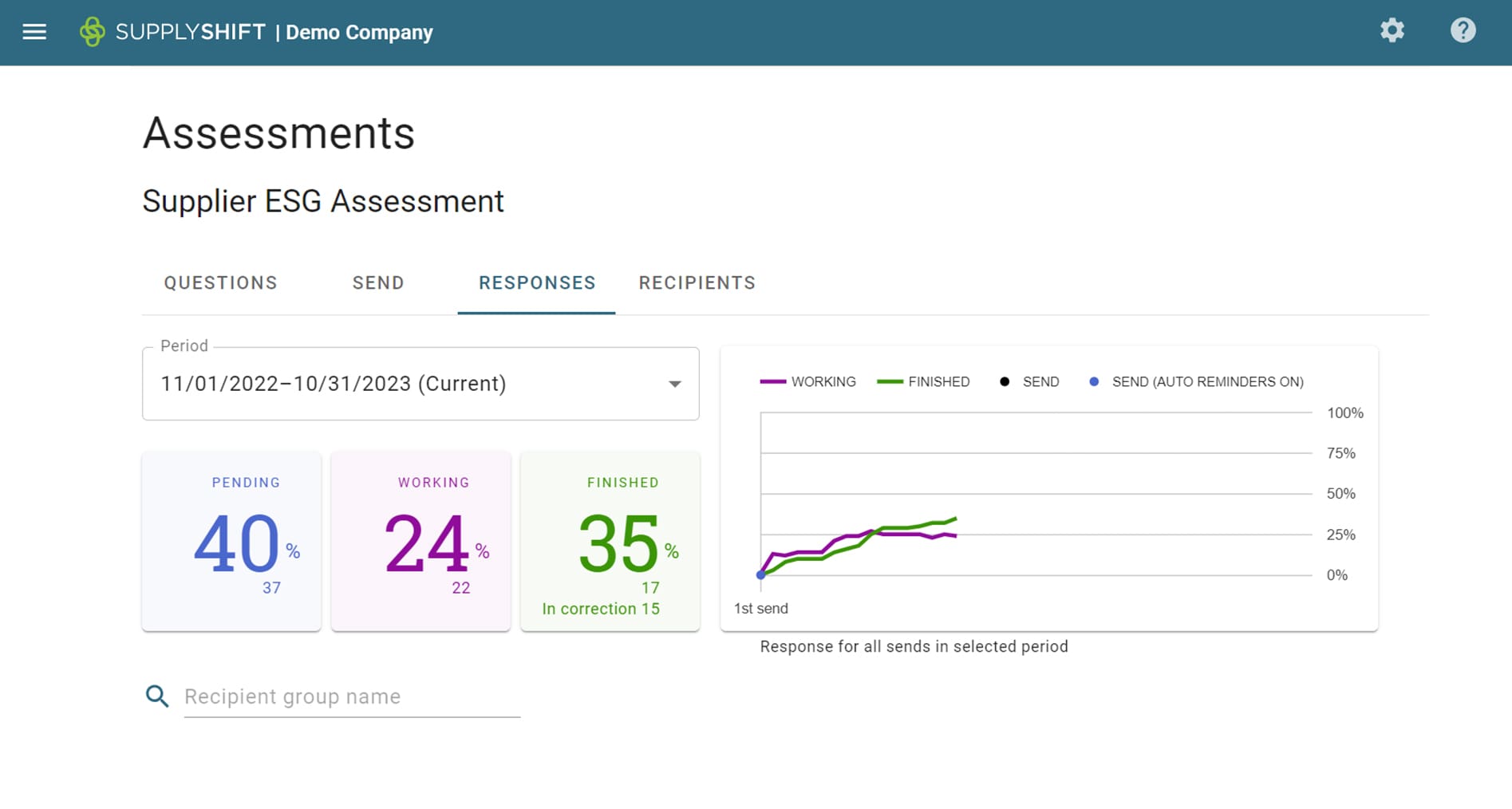Meet CSRD Reporting Requirements
The CSRD introduces an extensive reporting framework, requiring companies to provide detailed disclosures in areas including governance, strategy, environmental impact, and social practices. In total, companies will need to disclose over 1,000 data points, with the requirement for third-party assurance to verify accuracy.
The directive goes beyond traditional ESG reporting to incorporate eleven key topics, such as →
European Sustainability Reporting Standards (ESRS)
Environment
- Climate Change
- Pollution
- Water and Marine Resources
- Biodiversity and Ecosystems
- Resource Use and Circular
- Economy
Social
- Own Workforce
- Workers in Value Chain
- Affected Communities
- Consumers and End-Users
Governance
- Business Conduct
Cross-Cutting
- General Requirements and Disclosures
Simplify the Journey to CSRD Compliance
With SupplyShift, you can confidently meet CSRD requirements while leveraging that data for strategic sustainability progress. Our tools facilitate the efficient collection and management of ESG data from every tier of your supply chain, providing a comprehensive and transparent view of your company’s impact.

REAL-TIME TRACKING
Monitor progress of data collection, ensuring adherence to the CSRD reporting timeline.
DATA VERIFICATION
Ensure data is audit-ready with advanced analytics that identify inconsistencies.

Seamless Reporting
Export data outputs that match CSRD reporting requirements.
Start Preparing Now for CSRD
Whether you’re just starting your journey toward compliance or already have a materiality assessment in place, SupplyShift has you covered. Our solution is designed to align with your company’s specific stage in the CSRD preparation process.
No Materiality Assessment yet?
Let’s kick-start your journey by conducting a materiality assessment. We’ll help you identify and prioritize the ESG factors most relevant to your business, setting the foundation for your CSRD compliance strategy.
Already have a Materiality Assessment?
Great! We’ll match your findings with our suite of assessments to gather the data that meets your unique compliance needs. Upon completion, you’ll receive a detailed report covering KPIs that align with the requirements for CSRD material topics.
Recommended Assessments for CSRD
We suggest you pick from these:

Supplier ESG Assessment
A social, environmental, and business ethics performance assessment for your suppliers. Raise awareness, understand supplier risks, and continually improve conditions in your supply chain.

Human Rights Compliance Assessment
Identify the risk of forced labor and modern slavery at every level of your supply chain. Plus, comply with regional modern slavery legislation in Germany, the United Kingdom, France, Australia, and California.

GHG Leadership and Reporting Assessment
Understand management practices and reporting of greenhouse gases throughout your supply chain. Engage your suppliers to measure progress, reduce emissions, and mitigate climate risks.

Biodiversity
Assessment
Transform the challenges of reporting and regulations into action using the first biodiversity tool designed specifically to engage the upstream supply chain for crucial information about material impacts.
But you may also want to consider these:
Scope 3 Emissions Calculator
A comprehensive facility-level tool to measure emissions intensity of any supplier manufacturing facility.
Supplier Diversity, Equity & Inclusion Assessment
An assessment to help companies better understand and advance diversity and inclusion in the supply chain.
THESIS Index
A science-based performance management system helping retailers transform the consumer goods industry to deliver more sustainable consumer products.
Facility Mapping Assessment
Quickly map your supply chain, incorporate any information requests at any tier, and drive supplier responsibility progress.
Sugar Mapping Tool
Map and assess all sources of sugar and its derivatives, including non-certified supply chains, at every tier down to the mill. Leverage data to drive the social and environmental sustainability performance of your suppliers.
YESS Cotton Sourcing Risk Screen
Create sourcing dashboards with supplier profiles of cotton inputs and due diligence efforts. Map your cotton supply chain and use the YESS Cotton Sourcing Risk Screen to understand forced labor risk.
Manufacturing Sustainability Assessment
A set of standard, quantitative, and globally applicable KPIs for companies to track the sustainability performance of external manufacturing operations.
Apparel Sustainability KPI Assessment
A comprehensive facility-level assessment to measure factory sustainability performance in textile and apparel supply chains.
CSRD: Implementation Timeline
What is the CSRD timeline?
The CSRD’s phased implementation begins in 2025, based on 2024 data. Given the extent of information required by the directive, companies need to start early, especially those new to carbon emissions measurement or concerned about audit-readiness.
2024
(Reporting in 2025)
Companies already subject to NFRD; those with 500+ employees and listed on an EU-regulated market.
2025
(Reporting in 2026)
Non-SMEs listed on EU-regulated markers, and large private companies or subsidiaries with two or more of the following:
• 250+ employees
• €20M+ assets
• G40M+ revenue
2026
(Reporting in 2027)
SMES listed on EU-regulated markets, including subsidiaries.
2028
(Reporting in 2029)
Non-EU companies with €140M+ net turnover in the EU for each of the last 2 years, and have at least one of the following:
- Large EU subsidiary
- Subsidiary listed on an EU-regulated market
- Significant branch in the EU generating €40M+ revenue
Learn More About CSRD
Explore our resources to unravel the intricacies of CSRD and better understand its reporting obligations, key focus areas, and essential timelines.
CSDDD and CSRD – What’s the difference?
What is the difference between the CSDDD and CSRD, and how should you focus your efforts? The EU’s recent Corporate Sustainability Reporting Directive (CSRD) and...
CSRD & Supply Chain Sustainability: What You Need to Know
What is the CSRD? The Corporate Sustainability Reporting Directive (CSRD) is new legislation in the European Union that requires, elevates, and standardizes ESG...
Talk to Us About CSRD
Start your journey with SupplyShift’s CSRD Solution. Discover how we can help you navigate your unique ESG challenges, ensure compliance, and enhance sustainability performance across your supply chain.










